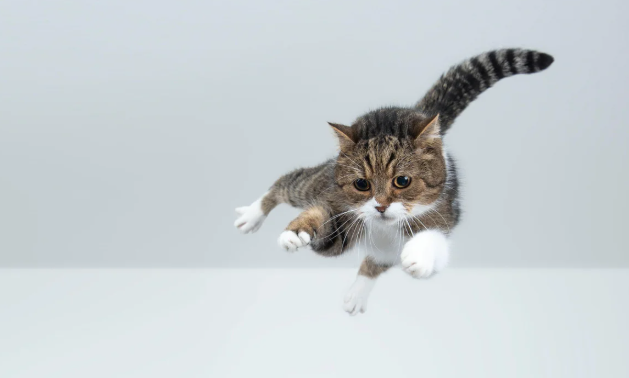Why Do Cats Always Land on Their Feet? The Science Behind Feline Agility
Cats have fascinated humans for centuries with their grace, balance, and uncanny ability to land safely on their feet after a fall. This remarkable skill, often called the “righting reflex,” has made cats symbols of agility and survival. But how do they manage to twist their bodies mid-air and avoid injury? Let’s explore the fascinating science behind why cats almost always land on their feet.
The Secret Behind the Righting Reflex
The main reason cats can land on their feet lies in their highly developed righting reflex. This reflex begins to appear when kittens are just three weeks old and becomes fully developed by seven weeks. It allows a cat to orient its body in mid-air so that its feet are facing downward before it lands.
Here’s how it works step-by-step:
-
Head Movement First:
As soon as a cat falls, it quickly rotates its head to face downward. The rest of the body follows this movement. -
Spine Flexibility:
Cats have an incredibly flexible spine made up of 30 vertebrae. This flexibility allows them to twist their upper and lower body independently to adjust their position in mid-air. -
Tail as a Balancer:
The tail helps stabilize and balance the cat’s rotation, acting like a rudder to fine-tune its direction. -
Leg Positioning for Impact:
Just before landing, cats spread their legs outward to increase air resistance, then pull them in to control their descent. -
Shock Absorption:
Finally, they bend their legs upon impact, reducing the force of the landing — a natural cushioning mechanism.
Physics and Cat Anatomy: A Perfect Combination
Cats’ ability to land on their feet is not just about reflexes — it’s also about physics. Their low body weight, flexible joints, and instinctive control over body rotation all play a crucial role.
| Factor | Description |
|---|---|
| Body Flexibility | The spine allows for independent movement of front and back halves. |
| Low Terminal Velocity | Cats reach a slower falling speed compared to larger animals, giving them more time to adjust. |
| Muscular Control | Strong core muscles help maintain balance and control in mid-air. |
| Padded Paws | Their soft paw pads absorb shock on landing. |
This combination of biology and physics gives cats an incredible survival advantage. Studies show that cats falling from greater heights sometimes suffer fewer injuries than from shorter falls — because they have more time to position their body correctly before landing.
Do Cats Always Land on Their Feet?
Despite their impressive abilities, cats don’t always land perfectly. The phrase “cats always land on their feet” is mostly true, but not absolute. Several factors can affect the outcome:
-
Height of the fall: If the fall is too short, there may not be enough time for the righting reflex to complete.
-
Surface type: Slippery or uneven surfaces can make it harder for cats to stabilize after landing.
-
Health and agility: Older or overweight cats may have slower reflexes and reduced flexibility.
-
Obstacles during the fall: If a cat hits something mid-fall, it may lose its orientation.
So while cats have a natural survival advantage, they’re not invincible. It’s always important for cat owners to keep windows, balconies, and high places safe to prevent accidental falls.
The Role of the Vestibular System
Inside a cat’s inner ear lies the vestibular system, a complex structure that helps maintain balance. It senses changes in direction, movement, and orientation — similar to the way humans regain balance after a spin. When a cat starts falling, this system instantly signals the brain about its position in space, triggering the righting reflex.
This rapid communication between the inner ear and the body’s muscles enables the cat to make split-second adjustments — one of the reasons why cats seem to move almost in slow motion while falling.
Fun Facts About Cats’ Falling Skills
-
Cats reach a terminal velocity of about 60 mph (97 km/h) — slower than most animals of similar size.
-
Astronaut researchers once studied cats to understand motion and balance in zero gravity environments.
-
Cats falling from higher floors (above 7 stories) in urban areas have been observed to sustain fewer injuries because they have more time to adjust their position before impact — a phenomenon called “cat high-rise syndrome.”
How to Keep Your Cat Safe at Home
Even though cats are known for their agility, safety should always come first. Here are some simple tips to prevent accidents:
-
Install secure screens or nets on windows and balconies.
-
Avoid leaving open windows in high-rise apartments.
-
Keep furniture or climbing shelves away from open edges.
-
Schedule regular vet check-ups to ensure your cat’s muscles and reflexes remain healthy.
Cats’ ability to land on their feet is one of nature’s most fascinating adaptations. Through a combination of the righting reflex, flexible anatomy, and remarkable balance, cats can twist and turn their way to safety. While this natural skill gives them an edge, it’s not a guarantee of protection from injury. Understanding how and why this reflex works helps us appreciate the amazing biology of our feline companions — and reminds us to keep them safe as they explore the heights they love so much.














Post Comment